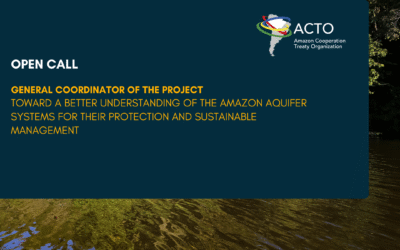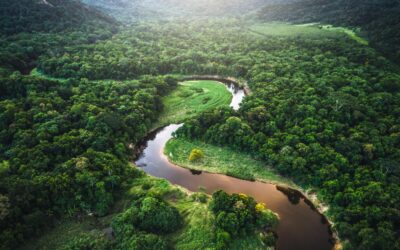Currently, the ARO is equipped with web services to share its data on Amazon biodiversity with interested institutions.
Delegations from the six ACTO Member Countries (MC) participated in the third meeting of the Steering Committee of the Amazonian Regional Observatory (ARO). On the occasion, they learned about the progress made, the results and agendas within the ARO.
The Amazonian Regional Observatory was created since decisions taken at the eleventh, twelfth and thirteenth meetings of Ministers for Foreign Affairs, which is the highest decision-making body responsible for setting the guidelines of the common policy. It evaluates all initiatives developed and takes the necessary decisions to achieve the objectives proposed in the Amazon Cooperation Treaty (ACT). The ARO was launched on November 10, 2021.
Isaac Ocampo, ARO’s data specialist, described the observatory’s contents, which are presented through thematic and integrative modules. He spoke about CITES and Biodiversity thematic modules, specifically the thematic lines and dashboards for graphical presentation of the information; moreover, he presented the progress made in the water resources and forests modules.

In relation to the Biodiversity module, since November 2021, ACTO has been integrated into the Global Biodiversity Information Facility (GBIF) and one of its actions within the network is to implement the Amazonian node that integrates data of occurrences of more than 65 institutions of ACTO Member Countries. Based on data refinement, reports are currently generated, and data are downloaded at the Amazon basin level. Based on this data, work has been conducted on the modeling of ecological niches of eleven species. In addition, ARO has now web services to share its Amazon biodiversity data with any institution interested in them.
Regarding the integrator modules, Isaac Ocampo explained that these modules present contents in a transversal association. The Geoamazon module is a tool with three information approaches: monitoring (time), thematic, and geographical scope (of each PM). An important point is the daily monitoring of hotspots in the Amazon region. The Amazon Networks module integrates all 242 water quality and hydrological monitoring stations in the Amazon region of five ACTO/MC (Bolivia, Brazil, Colombia, Ecuador and Peru) highlighting the difference in the frequency of updating data from each country. Likewise, the system already allows to generate some rain and flood alerts, which are being validated by the company responsible for the development of that module, Geodatin. In addition, he reported that the modules Digital Amazon and Our Amazon have the function of a repository of storage and search for information related to the priorities of the ARO.
Mauro Ruffino, coordinator of the ARO, informed that the ACTO, through the Bioamazon Project, will participate in the CITES COP 19, in November 2022, through a side event. During the event, it will be explained about the contributions of the Project to the implementation of CITES, and ACTO will prepare a Technical Note on how ARO can contribute to a regional vision of CITES implementation. “The challenge of ARO is to give a regional character to the information collected. All Member Countries are known to submit their annual national reports to the conventions (CITES, CBD, etc.), but there is no regional analysis with information from all Member Countries. Once the Technical Note is prepared, it will be officially submitted to all MC for their respective considerations, and subsequently, a consensus document will be sent to the CITES Secretariat,” he said.

Investments
In 2021, investments in the ARO amounted to more than US$ 1.1 million, of which US$ 926 thousand were allocated by the Bioamazon Project, channeled by the German Development Bank (KfW) for infrastructure works, purchase of equipment and computational development of the platform and modules, and US$ 180 thousand invested by the Brazilian Cooperation Agency (ABC) and ANA Brazil to make the ARO Situation Room viable.
Challenges
ARO’s challenges encompass four dimensions of sustainability: financial, technological, operational and institutional.
Regarding the financial aspect, about 80 percent of the investment was from the German government, through the Bioamazon ACTO Project, and about 20 percent by the Brazilian government, through the Amazonas/ANA/ABC Project. The expansion of services and the maintenance of the functioning of ARO will require regular and predictable contributions of resources.
In terms of technology, the addition of new modules and functionalities to the ARO will require the acquisition of new hardware equipment and software licenses, and the future updates of those already available. It should be considered to seek for partnerships with institutions of the Member Countries that could collaborate with the ACTO.
The operational axis involves the availability of qualified and stable human resources for the operation of ARO. As for the institutional aspect, the ARO has a Steering Committee, composed of technicians from the MC, who coordinate and take decisions. The Observatory, incorporated into the structure of the ACTO, observes the precepts of the unanimous decisions of the ACT, operationalized through ministerial mandates, decisions of the Amazon Cooperation Council (CCA), and management of the Coordinating Committee of the Amazon Cooperation Council (CCOOR).
Delegations
Ruffino opened the plenary to the participants of the third meeting of the Steering Committee.
Among the interventions, Marco Ehrlich, delegate of Colombia, highlighted the importance of organizing the official and relevant information in the ARO. He mentioned that this process has helped in the articulation and coordination among national institutions and is valuable not only for Colombia but for the region.
Néstor Acosta, from the delegation of Ecuador, mentioned that the Ministry of the Environment, Water and Ecological Transition (MAATE) held a workshop with practical exercises to address the modules and everything developed in the ARO. He also indicated that there is a commitment to continue contributing with all the information in all the topics of the ARO, and thus strengthen the regional efforts foreseen.
From the delegation of Guyana, Felicia Adams-Kellman, highlighted the efforts and work done within the ARO. She expressed that the collection and storage of information for the country has always been a challenge, so it is very interesting to see the information centralized in a database that can help in the future in the management of biodiversity. He reiterated the readiness to continue supporting the implementation of the ARO.
Jonatan Quevedo, from the delegation of Peru, reiterated the country’s commitment to continue participating in all ARO actions.
The third meeting of the ARO Steering Committee was held on May 4, 2022, in a virtual way.
Visit the Amazon Regional Observatory. Visit: https://oraotca.org/
Published in the Bioamazon Newsletter, issue n. 15, May-June 2022. ========================================================================











